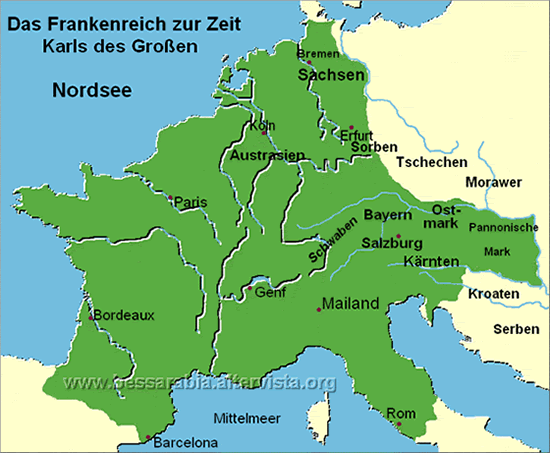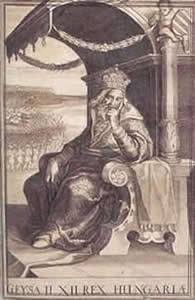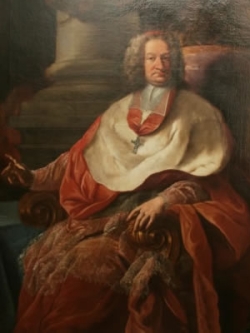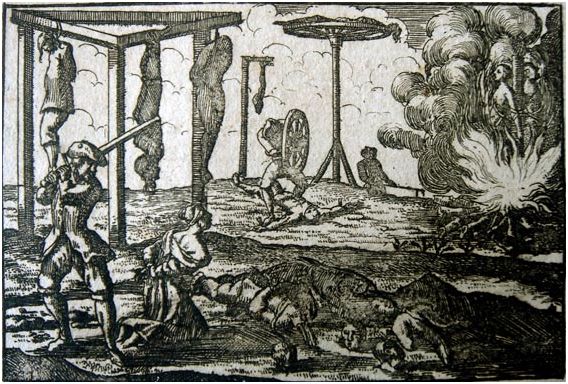You are in: Migration Museum > Migration Movements
Migration Movements1
(Part 3 of 4)
 nder the Carolingian Charlemagne, King of the Franks, the Eastern Alps, the Bavarian Eastern border (March of Austria), today's Carinthia and the Pannonian border, East of Vienna, were settled in the middle of the 8th century.
nder the Carolingian Charlemagne, King of the Franks, the Eastern Alps, the Bavarian Eastern border (March of Austria), today's Carinthia and the Pannonian border, East of Vienna, were settled in the middle of the 8th century.

The Frankish kingdom at the time of Charlemagne
In the High Middle Ages (12th to 13th centuries) German settlers were invited by Christianized Slavic princes into the country to increase the numbers of their subjects, and thus the size of their income.

Géza II, King of Hungary
(1141-1162)
The easternmost provinces of Prussia, the Baltic duchies, large parts of Poland and southern Russia, as well as broad stretches of Hungary and Transylvania2 were colonized by German emigrants.
After Transylvania, German settlers, from the Rhine-Moselle region, migrated in the 12th Century at the time of Géza II, to secure the eastern border and to promote professions (arts and crafts) and urbanization.
After a long break, the Germans (Danube Swabians) migrated to the ‘Danube countries’ in the 17th and 18th centuries under Leopold I, Karl VI, Maria Theresa, and Joseph II.

Stefan Jäger: The great migration of Swabians
German settlers also migrated to the newly acquired territories in the east that had been newly acquired by the Russian Czars (Peter the Great, Elizabeth I, Catherine II, Alexander I) in the 17th, 18th and 19th centuries.

Leopold Anton von Firmian
Examples of forced emigration include the expulsion of the Jews (1492) and the Moors3 (1609-1615) of Spain, the Huguenots under Louis XIV (1685), and the Salzburg 'Exulants'4 (1733) under Archbishop Firmian.

Persecution of the Huguenots
1 Thanks to S. Winkler for help with the English translation of this page
2 Transylvania = landscape, inside of the Carpathians curve which today belongs to Romania. From the 3rd century BC it was part of the Kingdom of Dacia, from 106 to 271 AD part of the Roman province of Dacia, since the 7th century of the First Bulgarian Empire, from the 9th/10th century to the 13th century of Hungary.
In the 10th century, to the border protection were settled Székelys (a subgroup of the Hungarian people), then from approximately 1150 German farmers and craftsmen (Transylvanian Saxons); from 1211 to 1225 the Teutonic knight extended in the Burzenland (historical border region in southeastern Transylvania). A Romanian population is attested certainly only since about 1210. In 1437 it came to the "Union of the three Nations" (Székely, Hungary, Saxony) to defence the advancing of Turks since 1432.
After 1493 until about 1530 the threat by the Turks led for to the reconstruction and development of the churches to fortified churches. After the battle of Mohács (1526) Transylvania came under Ottoman sovereignty; in 1688 or 1691 Transylvania fell temporarily under the Habsburgs (Austria) sovereignty, in 1699 (Treaty of Karlowitz) finally under the Habsburgs sovereignty, maintaining its autonomy; in 1848/49 briefly, shortly after the Austro-Hungarian compromise in 1867, reunited again with Hungary. The magyarization's politic encountered the resistance of the local Romanians and Saxons. By the Treaty of Trianon (1920) Transylvania returned to Romania, by the Second Vienna Award in 1940, Northern Transylvania and the Székely Land (Eastern Transylvania) came to Hungary and in 1947 by the Treaty of Paris all Transylvania came to Romania.
3 Moors = The Moors are understood as all those living as nomadic Berber tribes in North Africa, which in the 7th century were Islamized by the Arabs and supported them as a fighting force in their conquest of the Iberian Peninsula. In the Middle Ages, especially since the time of the Crusades, the Moors were primarily called Saracens. In 711 the Moors invaded the Christian kingdoms of the Visigoths, in what is now Spain and Portugal and Islamized them.
The Moors ruled for seven centuries on the Iberian Peninsula. Several centuries later, progressing from the north, the Christians reconquered (Reconquista) it in 1492 with the capture of Granada. That same year, the "Catholic King and Queen" Isabella and Ferdinand ordered the expulsion of the Jews, who did not want to convert to Christianity. Muslims in Spain, however, were assured that their religion and customs were tolerated. The crown kept her promise for only a few years as in 1502 the Muslims were given the choice to accept the Christian faith or to leave the country. Most of them were baptized, but remained faithful to their customs and secretly continued to practice their Islamic faith. The Inquisition took tougher action against the nonconformist minority. Arabic language, dancing, baths and writings were banned. In 1568 a revolt erupted that would take the military two years to put down.
In 1609, Spanish King Philip III ordered that all Arabs were to leave the country. Approximately 300,000 residents of Spain were deported to North Africa. This was the precurser of the ethnic cleansing, in a more or less bloody way, that was carried out in the 20th century in Europe. The deportees settled in what is known as Morocco, Algeria and Tunisia.
The expulsion was justified by the fact that Spain should be a Catholic country and minorities would no longer be tolerated. In addition to religious motives, military and political motivations played a role in the making of this decision. Spain felt threatened, at that time, due to the rise of the Ottomans (a historical Turkic people in Asia Minor, consistently referred to as Turks since 1923) in the Mediterranean and insinuated that they sympathized with the Muslims from Asia Minor.
4 Exulant = A Protestant who was exiled from one of the countries of the Catholic Habsburg monarchy in the 17th and 18th centuries.


